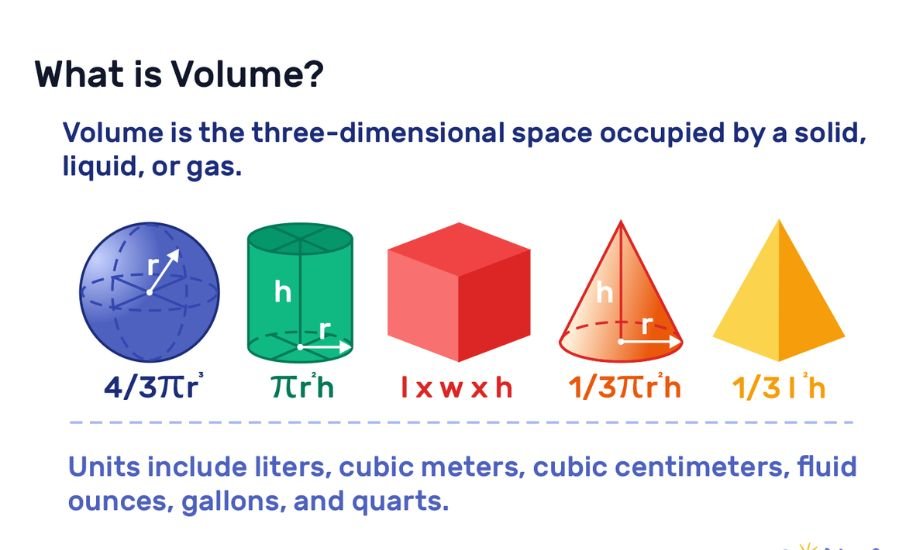Have you ever wondered what is volume and why people talk about it so much in science, math, and even in daily life? From pouring milk into a glass to filling a swimming pool, volume is all around us. It is one of those basic ideas that helps us understand the size of things—not how long or tall, but how much space they take up.
In simple words, what is’ volume means the amount of space something takes inside a container or object. For example, how much water you can pour into a bottle is its volume. It’s not about weight or length, but about space.
In this article, we will explore in detail what is volume, how we measure it, where we see it in real life, and why understanding it is very important. Let’s dive in and learn together.
What Is Volume in Science?
In science, the question what is volume means figuring out how much space an object or substance takes up. Scientists use volume to study liquids, gases, and solids. It helps in understanding how big or small things are in terms of space, not weight.
For example, if you have a balloon and fill it with air, the space that the air takes inside the balloon is its volume. Whether it’s water, oil, or even smoke, everything has volume. Scientists use special tools like measuring cylinders and beakers to know the volume of liquids.
The basic unit for measuring volume in science is the liter or milliliter for liquids, and cubic meters or cubic centimeters for solids. So, whenever someone asks what is ‘volume in science class, now you know the clear answer.
What Is Volume in Math?
In math, what is volume refers to the space inside 3D shapes like cubes, boxes, spheres, and cylinders. It’s calculated using formulas. For example, the volume of a cube is length × width × height.
Let’s say you have a box that is 2 meters long, 3 meters wide, and 4 meters high. To find the volume, you multiply:
2 × 3 × 4 = 24 cubic meters. That is the amount of space inside the box.
In math classes, students learn formulas for different shapes to calculate volume. This helps in solving real-life problems, like how much soil is needed to fill a pot or how much water is required to fill a tank. Now when someone says what is ‘volume in math, you can answer with confidence and even help others.
Everyday Examples: What Is Volume in Real Life?
So, what is volume when we are not in a classroom or a lab? It’s something we use every day without even knowing it. Here are some simple examples:
- Cooking: When you measure 1 cup of milk or 2 liters of water, you’re using volume.
- Shopping: Buying a 5-liter paint can? That’s volume.
- Traveling: Your luggage space is measured in volume (liters).
- Cleaning: A bucket holds 10 liters of water—that’s volume again.
Understanding what is ‘volume helps you make better decisions. Like knowing how many bottles of soda you need for a party or what size storage box to buy for your toys or clothes. Volume isn’t just for scientists or math lovers—it’s for everyone.
How to Measure Volume?
So, what is volume and how do we measure it? There are many ways, depending on the object:
Liquids
We use liters, milliliters, or gallons to measure liquids. Tools like measuring cups, jugs, or syringes are common.
Solids
For solid shapes, especially regular ones, we use formulas. For example:
- Volume of a cube = side × side × side
- Volume of a rectangular box = length × width × height
Irregular Objects
If the shape is weird (like a stone), we use water displacement. Put the object in water and see how much the water level rises. That rise is the volume.
So, whenever you’re asked what is volume and how it’s measured, you now know three clear answers.
Different Units for Volume
What is volume without the right units? It’s like having money with no name for it. Here are some common units used to measure volume:
- Milliliters (ml) – For very small volumes, like perfume or medicine.
- Liters (L) – For larger liquids like soda or water bottles.
- Cubic centimeters (cm³) – Often used in science labs.
- Cubic meters (m³) – For very big volumes like room space or tanks.
- Gallons – Common in the US for fuel and milk.
Choosing the right unit is important. You don’t want to measure a swimming pool in milliliters. Understanding what is volume also means knowing which unit to use.
Why Is It Important to Know What Is Volume?
Knowing what is ‘volume is more important than many people think. Here’s why:
- Safety: You must know volume when mixing chemicals, cooking, or giving medicine.
- Planning: Builders and designers use volume to plan spaces and materials.
- Saving: Smart volume use means fewer resources and less waste.
- Business: Shipping companies use volume to set prices. More volume means higher costs.
Volume affects our health, our homes, and even our money. So the next time someone asks you what is volume, you can say, “It’s not just numbers—it’s everyday life.”
Features What Is Volume
| Feature | Details |
| Keyword | what is volume |
| Definition | Volume means the space something takes up. |
| Used In | Math, science, daily life, cooking, packing, measuring liquids. |
| Common Units | Liters (L), milliliters (mL), cubic meters (m³), gallons. |
| Tools to Measure | Measuring cups, rulers, volume formulas, water jugs. |
| Real-Life Examples | Water in a bottle, toys in a box, milk in a glass, gas in a balloon. |
| Math Shapes Used | Cubes, cylinders, spheres, and other 3D objects. |
| Helps With | Planning, organizing space, saving time, and using resources wisely. |
What Is Volume in Liquids vs. Solids vs. Gases
Let’s break down what is volume for different types of matter:
Liquids
Liquids have a definite volume but not a fixed shape. They take the shape of their container. Water, milk, and juice all have volume.
Solids
Solids have both a fixed shape and volume. A box, a book, or a ball has a specific volume that doesn’t change easily.
Gases
Gases have volume too, but it can change. A balloon filled with air shows gas volume. The more air, the bigger the balloon.
Even though they’re all different, understanding what is volume in each case helps us know how they behave in different situations.
What Is Volume in Computers and Audio?
In technology, the term what is ‘volume has a whole different meaning. It often refers to:
- Sound volume: How loud or soft audio is.
- Data storage volume: In computers, a “volume” can mean a storage space like a hard drive.
Though different from the physical space meaning, it still follows the core idea of “how much” something contains—whether it’s sound energy or data bytes.
Read More: How-many-cups-in-a-quart-easy-guide
Fun Activities to Learn What Is Volume
Teaching kids what is volume can be fun. Try these:
- Water Play: Use cups, spoons, and bottles to explore different volumes.
- Building Blocks: Make boxes of different sizes and measure them.
- Cooking Projects: Let them pour and measure ingredients using measuring cups.
Making learning fun helps children understand that what is ‘volume isn’t just schoolwork—it’s part of real life.
Top Benefits of Understanding What Is Volume
- Helps in real life – Knowing what is ‘volume helps you cook, clean, and pack things better every day.
- Saves space – You can fit more items in a box or bag by understanding how much space they take.
- Makes math easier – Volume is a big part of math and learning it makes schoolwork simpler and more fun.
- Useful for jobs – Many jobs like builders, engineers, and chefs use volume every day.
- Improves thinking – Learning about volume helps your brain grow smarter and solve problems.
- Keeps things safe – You won’t overflow a tank or spill juice if you know how much volume it can hold.
- Good for shopping – You can buy the right size of bottles, containers, or bags when you understand volume.
- Fun to learn – You can explore volume with water, sand, blocks, and even balloons.
- Helps the environment – Using the right volume means less waste and smarter use of things.
- Makes you confident – When you understand what is volume, you feel smart and ready to help others too.
Tips for Remembering What Is Volume
Need help remembering what is volume? Here are simple tricks:
- “V” is for Volume and Vase: Think of filling a vase with water.
- Use Real Life: Link the idea to bottles, boxes, or rooms you use every day.
- Practice: Keep measuring things at home to get used to it.
The more you relate what is ‘volume to everyday things, the easier it gets.
Volume Is Everywhere
Let’s wrap this up. Now we know that the answer to what is ‘volume is simple—it’s the amount of space something takes up. But it’s also big. Volume helps in cooking, shopping, science, building, and even playing. It connects the world in more ways than we notice.
Whether you are filling a cup, buying a fish tank, or storing files on your phone, volume plays a role. The next time someone asks, “What is volume?” you won’t just know the answer—you’ll live it.
Conclusion
So now we know what is volume means the space inside something. It can be a cup of milk, a box of toys, or even the air in a balloon. Volume helps us in many ways every day. We use it when we cook, clean, play, and even when we travel. Isn’t that cool? It’s like volume is hiding in everything we do. If we understand volume, we can do things better and smarter. You don’t need to be a scientist to know it. You just need to look around and notice the space things take up. So next time you hear what is volume, smile and say, “I know this.”
Learning what volume is is not hard at all. It’s fun when you try it with games, blocks, or water. You can measure things at home and see how big or small they are. It’s like a little magic trick you can do anytime. Volume is not only in books, it’s also in your kitchen, your school bag, and even your bath tub. Keep asking questions and keep exploring. The more you practice, the more you will remember. So go ahead and teach someone else what you learned. That’s the best way to become a volume expert.
Stay Connected With: Sauk-city-wi-county-a-gem-in-wisconsin
FAQs
What is volume in simple words?
Volume is the amount of space something takes up. For example, how much water fits in a bottle shows its volume.
What is volume used for?
We use volume to measure liquids, boxes, rooms, and more. It helps us know how much something can hold.
What is ‘volume in math?
In math, volume means the space inside a 3D shape like a cube or cylinder. We measure it in units like liters or cubic meters.
What is ‘volume in real life?
In real life, volume is used when we cook, fill a tank, or pack items in a box. It helps us fit things properly.
What is volume of water?
The volume of water tells us how much water is in a container. It’s measured in liters, milliliters, or gallons.






